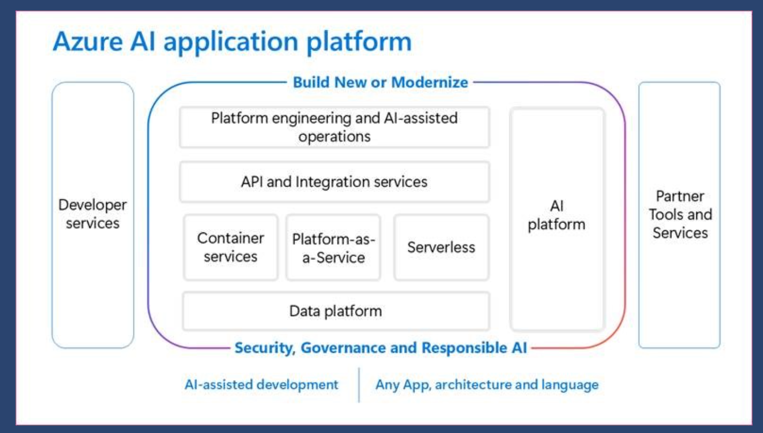Build AI Apps on Azure
AI Apps Overview

Demo Script
Initial Script to Build AI Applications on Azure
1https://azure.github.io/Cloud-Native/30-days-of-ia-2024
2
3
4https://azure.github.io/Cloud-Native/30-days-of-ia-2024/use-generative-ai-to-build-intelligent-apps
5
6Build intelligent AI-Apps using Azure Services
7
81. Azure Application Platform
92. Azure Data Platform
103. Azure AI
11
12
13
14how to build with cloud technologies like
15Azure Kubernetes Service (AKS),
16Azure App Service,
17Secure API Management, and
18GitHub Copilot
19
20
21The application is built using a three-part architecture consisting of a
22back end,
23middleware, and
24front end,
25
26deployed on either Azure Kubernetes Service (AKS) or Azure App Service.
27This architecture forms the foundation for integrating modern cloud and AI technologies.
28
29
30
31Application flow
32The content generation process in the application is simple yet powerful. Here is how the flow works, from the users perspective.
33
34User-input. The user provides details, such as the type of content they need — whether its an email campaign, social media post, or blog article.
35
36Back-end processing. The system retrieves necessary data, such as customer demographics, product details, and relevant information stored in the back end.
37
38Content generation. The middleware communicates with "Azure OpenAI" Service to generate content based on the provided input and back-end data,
39helping to ensure that the content is contextually relevant
40
41Result display. The generated content is then displayed on the ReactJS front end, where the user can review, copy, and implement it directly into their marketing campaigns.
42
43
44
45
46Azure OpenAI Service:
47At the core of content generation is Azure OpenAI, which uses GPT models to create coherent and relevant content based on user input.
48The Chat Completion API (GPT-4o) generates the text, while the embedding model helps ensure that data retrieved for content is semantically relevant to the user needs.
49
50
51Azure Key Vault:
52For secure storage of secrets such as API keys, credentials, and sensitive configuration data, Key Vault is integrated into the system.
53This helps ensure that all sensitive data is stored securely and retrieved only when needed.
54
55
56Microsoft Entra ID (formerly Azure Active Directory):
57Microsoft Entra ID is used for authentication and identity management, supporting secure access to the back end and to APIs.
58It helps effectively manage user roles and access permissions.
59
60
61Managed identity:
62The application uses managed identity to securely access Azure resources without hard-coding credentials.
63This simplifies the authentication process when interacting with services like Key Vault and Azure Cosmos DB.
64
65
66Azure App Service and Azure Kubernetes Service (AKS):
67The application supports two deployment models: App Service and AKS.
68Both provide scalable infrastructure but differ in flexibility
69and complexity (more on this in the "Choosing the right deployment technology for you" section).
70
71
72Azure API Management:
73API Management manages the API gateway, controlling access between the front end, middleware, and back end.
74With features like Cross-Origin Resource Sharing (CORS), throttling, rate limiting, and authentication,
75API Management supports efficient communication and security across the system.
AI App Development Notes
Note
This folder contains examples and scripts for building AI-powered applications using Azure. More detailed walkthroughs and integrations will be added as development progresses.